You can easily find lists of ‘traditional’ Kazakh foods… but what about all the other food we eat? Below, I attempt a brief listing of food in Astana, but I welcome your additions…
Foods to Eat in Kazakhstan
Airan. Drinkable yogurt, usually unflavored. Handmade in yurts in Mongolia; sold as a commercial staple in supermarkets in Kazakhstan. Common and served in cafeterias as a drink.
Baursak. Fried bread spheres, much like a donut except unsweetened. Delicious when fresh; soaked in oil.

Beshbarmak. Boiled noodles (shelpek) in an oily meat sauce, with sheep meat, potatoes, carrots, and onions served on top. Widely regarded as Kazakhstan’s national cuisine, and served on special occasions.
Borshch. Yes, you can get this famous Russian soup here. Dark purple with chopped vegetables and beets, warmed over and served with a dollop of sour cream. Delicious. Vegetable soups, solyanka (pickle and meet soup), and buckwheat, pea, or grain-based soups are also common in cafeterias.
Bread. Lord, you don’t go through life without bread. Use to dip in sauce, or eat alongside any meal. Available quite cheaply at most stores and restaurants alongside the main meal.
Chechil. Dried and salted string cheese, found for $2 a pack at the supermarket, wrapped in a little plastic package and looking approximately like a skein of yarn. Pull apart and eat with beer. May be making an appearance in America soon – keep an eye out!
Chook-Chook. Soft bits of dough fried and then soaked in a sugar glaze; served in a sticky mass and available at the supermarket.
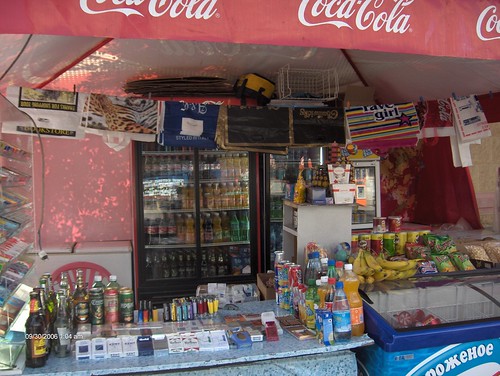
Coca-Cola. Judging by its frequency in every shop, restaurant, and party, this belongs on the list. Variants include Coke Lite, Fanta, Sprite, and limonad, a fizzy fruit-flavored drink.
Dill. A dish is not complete without a generous garnish of dill leaves (or failing that, parsley). Known as ukrop in Russian, I’ve heard an even better name in Kazakh: askok, which literally means “food-green.” As in, the only spice you need.
Doner. Has conquered the world. As you would expect: small kiosks, lukewarm meat layered with potatoes, carrots, some greens, and a generous load of mayonnaise, forming a sort of Turkish burrito. Sold from kiosks and mall food courts; quality is quite variable depending on heat and freshness.
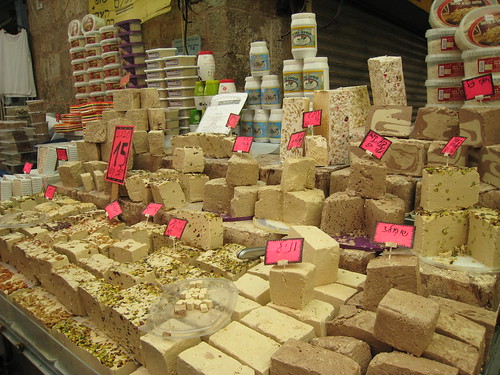
Halva. A sweetened sunflower seed paste, common in Russia. Usually pinched from a soft block and eaten with tea. My sister has become addicted and now buys it in America. I prefer the chocolate version, or the one with raisins. My housemates are less than happy when I pick all the raisins out and leave the paste, however…
Garneeyr. In many cafeterias, meat and grains are purchased separately. The latter are called garniir and may include noodles, potatoes, or grechka, a boiled dark-brown buckwheat that has a hearty-but-bland flavor.
Jam, or vareniya. Eat over bread, found in pastries, add to tea for flavor, or even eat by the spoonful over a late afternoon tea. Myod (honey) is another common sweetener.
Jent. A hard grain like millet, soaked in sugar and oil, eaten as a dessert. Traditional but not often found now.
Katchup. Yes, Heinz, and all the rest. Ketchup is one of the most common garnishes for fries, noodles, dumplings, anything; ostriy ketchup has a slight kick to it.
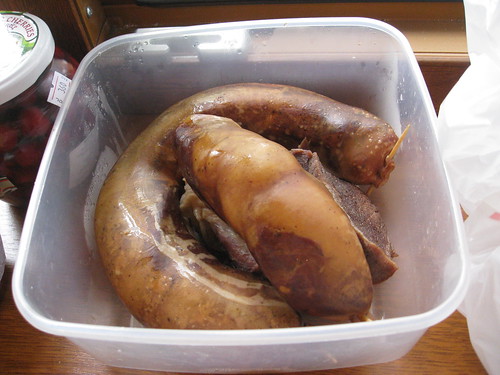
Kazy. Horse-meat sausage, with an intestinal outer lining, and chunks of fat and meat stuffed inside. I find it delicious; the highlight of a celebration meal. There are numerous other sausage and meat dishes, including shuzhuk, karta, zhaya, and more. Kazy is not uncommon, but a bit expensive; usually a treat.
Klub Sandvich. Multi-layered towers of dried bread and chicken, cheese, or tomatoes, in imitation of the west; usually served with fries. Common at many city restaurants.
Koumiss. Fermented mare’s milk. Watery and sour, with a nice kick. More commonly found in summer and early fall, and usually for special occasions. See also Shubat.
Kurt. A hard little lump of dried, salty cheese. Useful on long treks on horseback across the steppe, especially when herding sheep. Now more often seen for 50 tenge (30 cents) each in little buckets by the checkout counter of a mini-mart. Some people store them in office desk drawers or take with while traveling.
KFC. Yes, that’s Kentucky Fried Chicken, and there are standalone stores and mall kiosks across Almaty and Astana. One of the busiest restaurants around, and there’s always a long line for the Boksmaster and other local variants. Other foreign chains include Burger King, and Hardees. At all of them, there is a preponderance of mayonnaise on sandwiches.
Kuyrdak. Chopped liver, sometimes as a stir-fry over noodles or potatoes. Somewhat common at home or in a cafeteria; not my favorite.
Lagman. Hand-rolled noodles in a stew of oil, usually with meat, onions, pepper, potatoes, and some spices on top. More common at ‘Uzbek’ restaurants; there are numerous variants.
Latte. The young and the well-off frequent cafes with friends, ordering a large latte, cappuccino, or frozen coffee, commonly with commercial syrups or sugar on the side.
Makaron. Macaroni noodles are a staple, sometimes fried with bits of meat; other times boiled. Usually heavily oiled and with few garnishes.
Manti. Oval-shaped steamed dumplings with a heavy pressed dough, sheep meat or pumpkin, and sometimes served with sour cream or tomato sauce. Common at parties as well as available frozen. “Lazy Manti” is a variation in which meat is simply rolled up in dough, sliced, and cooked.
Morozhenoye. Ice cream. Sold in small tubs at the supermarket, in plastic-wrapped logs, and in single-serving frozen treats. The latter include Magnum chocolate bars, as well as squirts of vanilla or chocolate icing in a soggy cone, all wrapped in a pouf of plastic. Eaten in the summertime; you’ll get stares for eating ice cream in the winter and it’s forbidden if you’ve a sore throat.
Oil. A proper meal involves some sort of very oily potatoes, noodles, meat, or salad. Non-negotiable.
Pelmeni. Russian dumplings often served in an oily sauce with green herb flavoring, as well as sour cream.
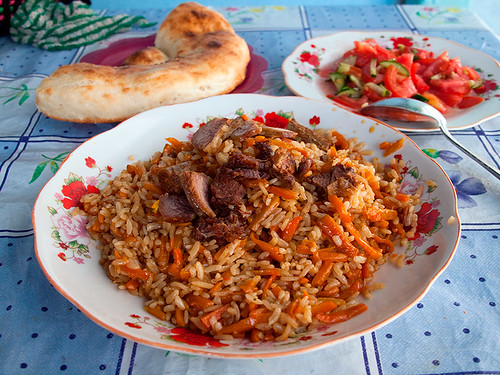
Plov. Oily yellow rice with flecks of mutton and carrots, as well as lumps of fat. A staple food sometimes served in cafeterias as well as at celebrations. Uzbeks add raisins, chickpeas, and other tasties. Cooked in a large kazan (cauldron) Traditionally eaten with one’s right hand, pinching the rice grains together with a sweep of the hand; in a good plov, the oil runs down your wrists as you eat.
Salat. This isn’t a western salad with greens; no, it’s usually something quite a bit heavier, involving a dense mix of chopped potatoes, cucumbers, carrots, or tomatoes. Variants include an olivye of peas and potatoes; grecheskiy salat of tomato, cucumber, and sour brinza or feta cheese; and a Russkiy salat of potatoes, pickles, and beets.
Samsa. Is the word borrowed from the Indian samosa? Perhaps. But like all good Kazakh food, vegetables are few in here. Instead the focus is on meat, chicken, or cheese, enveloped in a thin hard puff of baked pastry. Cheap if bought on the street.
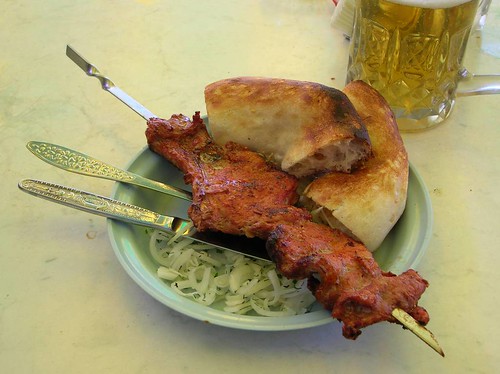
Shashlik. Shish-kebabs of mutton, beef, or chicken, often served with flat lepeshka bread and onions or other vegetable accessories; sometimes served plain. Delicious if freshly grilled with spices.
Sel’t. Sliced herring, served as the bottom layer of a chopped beetroot and potato salad, or eaten over bread. Often preserved and eaten raw.
Smetana. Sour cream. This goes over everything, from bread to noodles to dumplings. My housemate insists that thick homemade sour cream from the village is the best.
Shubat. Fermented camel milk. Sour. Found seasonally in some restaurants and shops. Similar to Koumiss, but perhaps a bit thicker.
Sorpa. Broth, or bullion, usually drunk from a tea-bowl after a satisfying meal of beshbarmak. Warm, oily, meat-flavored, and a touch salty == delicious. Usually found at home after a special meal.
Sushi. Sushi takeout is springing up across the city and popular with younger folks. Also available in food courts, and a highlight of the pricy Raddisson buffet favored by business elites.
Tea. Plain black tea, traditionally taken with milk and sugar (or salt in Mongolia). It may also be taken with spoonfuls of jam stirred in, or with a simple lemon for garnish.

Tort. Cake, but not your typical American birthday cake with a barbie doll figure on the top. No, it’s usually round, dense, with thick lardy icing, and a sugar glaze on top. There may be vague flowers, sliced fruit in a glaze of corn syrup, or other decorations. Usually multi-layered with jam, honey, cream, or nuts inside. Varieties include king cake, myodoviy (honey cake), and a variant of tiramisu.
Tvorog. Russian cottage cheese, smaller and a bit drier than the American version. Usually sweetened with sugar; common baked onto the top of a small round pastry or served as one of many items to put on bread with tea.
Varenniki. Russian dumplings, boiled and moon-shaped, with a potato puree filling inside. Sour cream is essential. Widely available.
Vodka. Naturally. Beer, wine, and the very lightly-alcoholic koumiss are also popular.
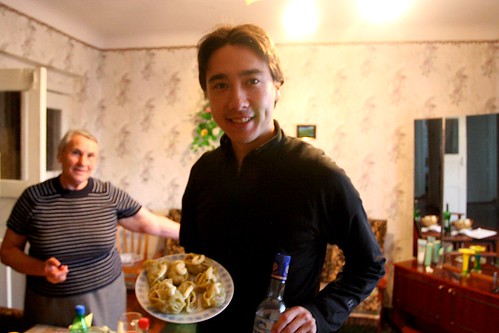
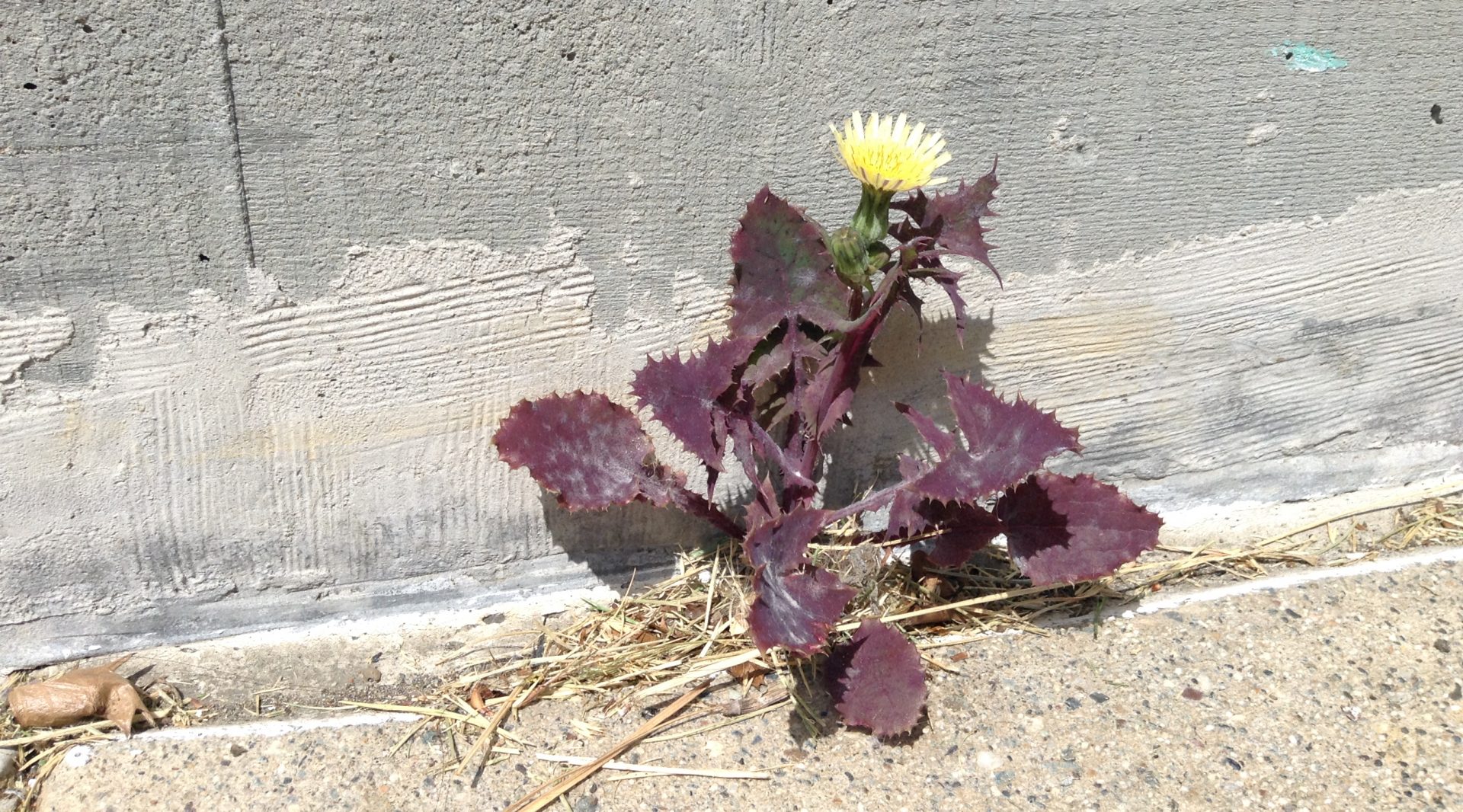
SO MUCH of this is similar to the food I ate while living in Turkey! Made me so hungry for some manti.
Mmm, definitely shared food cultures. I love manty and have made it at home (sort of, with ground beef) as well as found it at scattered restaurants in larger American cities.
sounds lovely but very fatty food. I’ll have to be careful not to go too native.
A Kazakh here. Kurt, beshparkmak, borshch, sorpa, smetana, shashlik, kazy, and airan are simply delicious – my all time favorite food. The first, must- eat foods to eat when coming to Kazakhstan are beshparmak, kurt, and kazy (as mentioned earlier, this is horse meat). A Kazakh beloved phrase (not very known) is “A prince on a white and a tasty horse.”
I haven’t heard that! I like the phrase 🙂